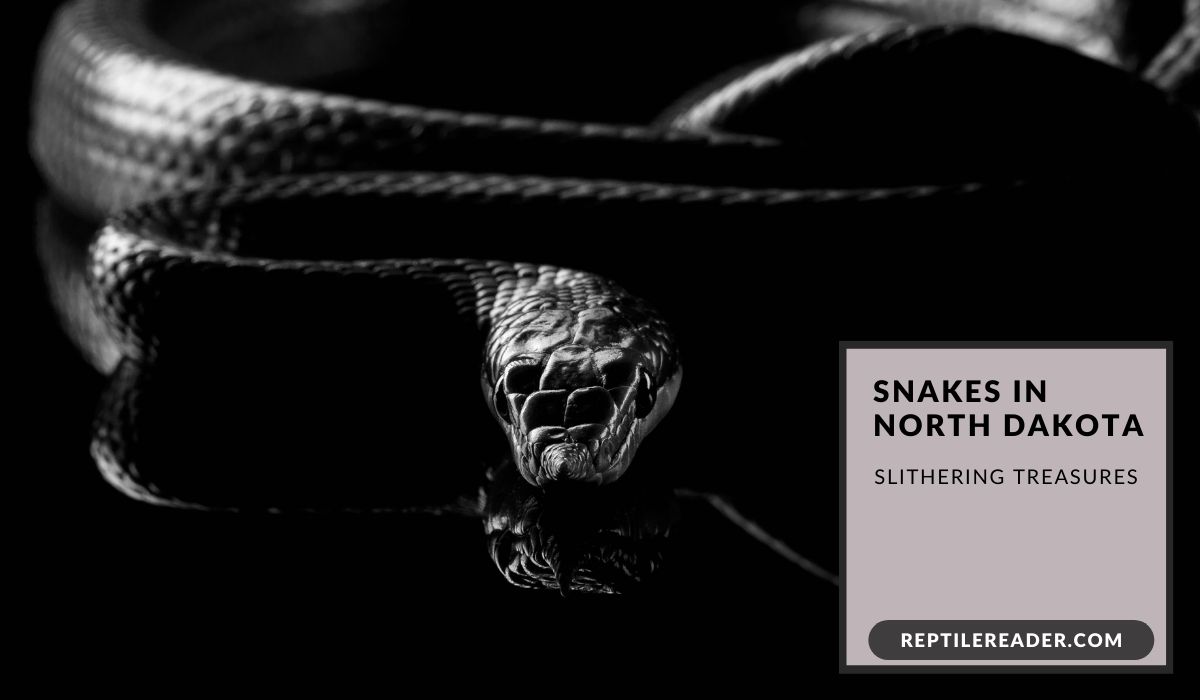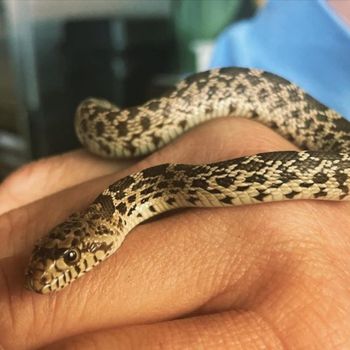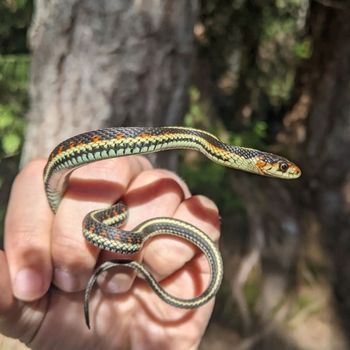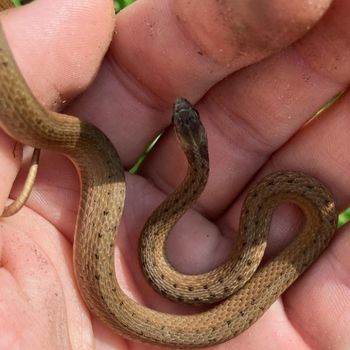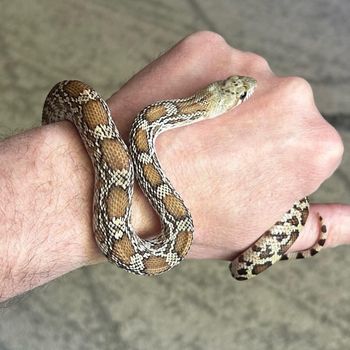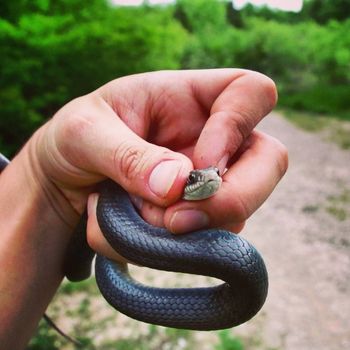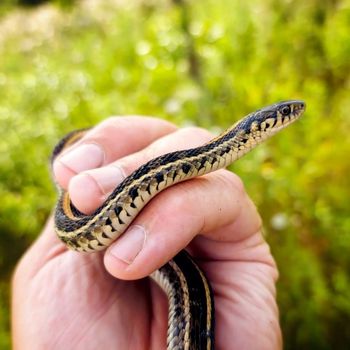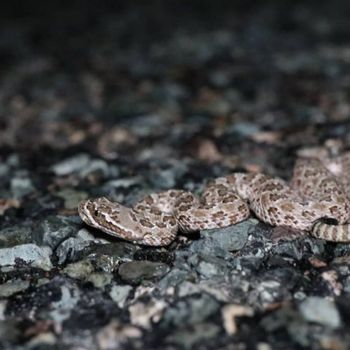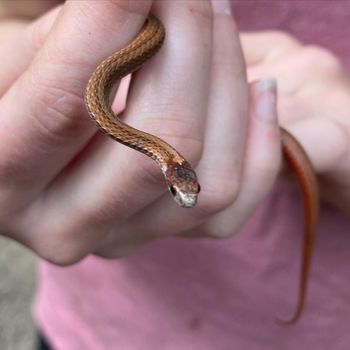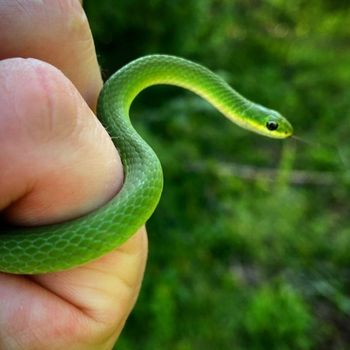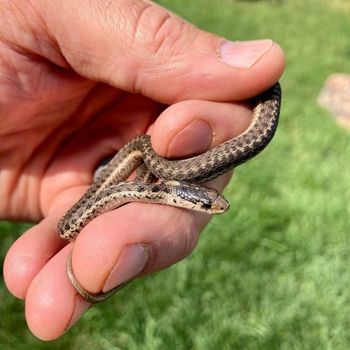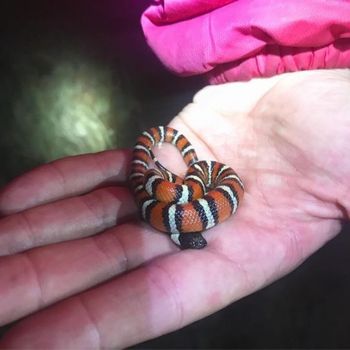Snakes in North Dakota: Slithering Treasures
Did you know that there’s a surprising amount of slithering diversity in the great plains of North Dakota? That’s right, this beautiful state is home to a remarkable number of snake species, all of which add a unique flavor to the local ecosystem.
In fact, believe it or not, there are 13 different species of snakes that can be found in North Dakota! Each one is as fascinating as the next, and we’re here to help you get to know them better.
In this blog, we’ll be taking a closer look at these incredible creatures, discussing their habits, habitats, and distinguishing features. So, buckle up, my ophidian friends, as we embark on a serpentine adventure through the snake-infested wilds of North Dakota!
| # | Name | Details | Image |
| 1 | Bullsnake (Pituophis catenifer sayi) |
| 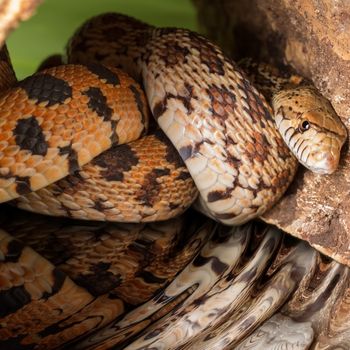 |
| 2 | Common Garter Snake (Thamnophis sirtalis) |
| 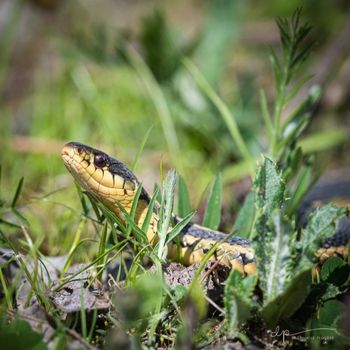 |
| 3 | Dekay’s Brownsnake (Storeria dekayi) |
| 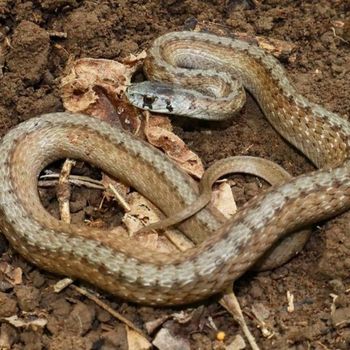 |
| 4 | Florida Brown Snake (Storeria victa) |
|  |
| 5 | Gophersnake (Pituophis catenifer) |
| 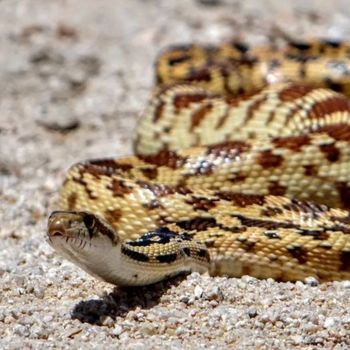 |
| 6 | North American Blue Racer (Coluber constrictor foxii) |
| 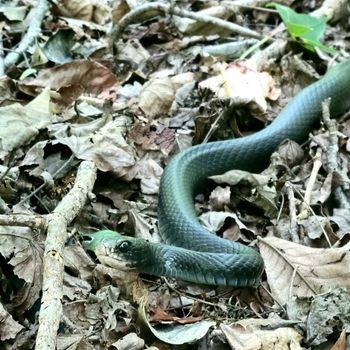 |
| 7 | Plains Garter Snake (Thamnophis radix) |
| 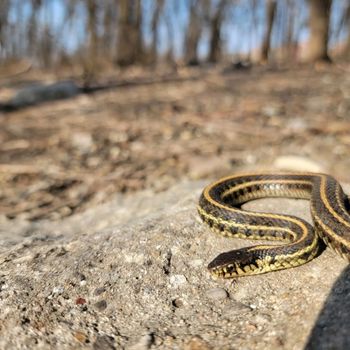 |
| 8 | Plains Hog-nosed Snake (Heterodon nasicus) |
| 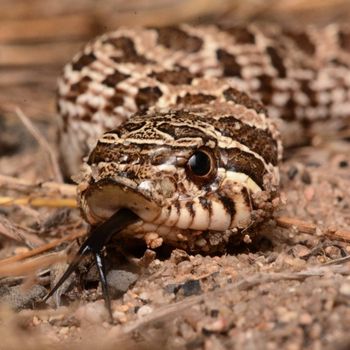 |
| 9 | Prairie Rattlesnake (Crotalus viridis) |
| 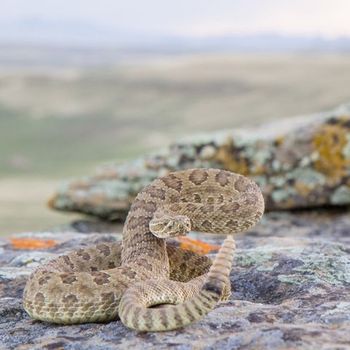 |
| 10 | Red-Bellied Snake (Storeria occipitomaculata) |
|  |
| 11 | Smooth Green Snake (Opheodrys vernalis) |
| 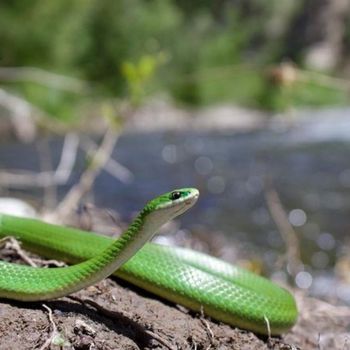 |
| 12 | Terrestrial Garter Snake (Thamnophis elegans) |
| 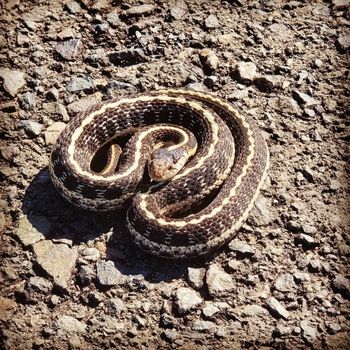 |
| 13 | Western Milksnake (Lampropeltis gentilis) |
| 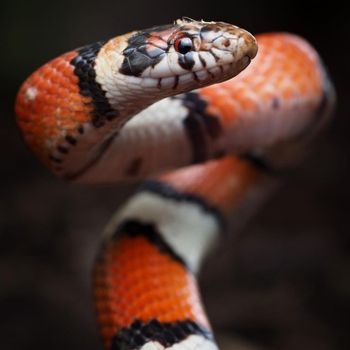 |
13 Snakes You Can Find in North Dakota
In the state of North Dakota, a fascinating array of serpents can be found slithering through its diverse landscapes. From venomous to harmless, each species has its unique story to tell. Below, we’ll explore the wonders of these often misunderstood creatures of North Dakota, from their natural habitats and behaviors to the challenges they face in our changing world.
1. Bullsnake
- Scientific Name: Pituophis catenifer sayi
- Common Name: Bull snake
- Size: 4-6 feet (1.2-1.8 meters)
- Natural Habitat: Grasslands, deserts, woodlands, and agricultural areas
- Color: Brown or yellowish with dark blotches
- Habitat: Grasslands, deserts, woodlands, and agricultural areas
- Maximum Size: 4-6 feet (1.2-1.8 meters)
- Diet: Rodents, rabbits, ground-nesting birds, and eggs
- Reproduction: Lay eggs in clutches of 5-22
- Venom: Non-venomous
- Conservation: Least concern
The Bullsnake (Pituophis catenifer sayi), a non-venomous constrictor, measures 4-6 feet (1.2-1.8 meters) and exhibits a brown or yellowish color with dark blotches. Found in grasslands, deserts, woodlands, and agricultural areas, these diurnal and terrestrial snakes primarily feed on rodents, rabbits, ground-nesting birds, and eggs. During the reproduction, the female Bullsnake lays egg clutches ranging from 5-22. With a conservation status listed as “Least Concern”, the Bullsnake is not currently under threat in North Dakota.
2. Common Garter Snake
- Scientific Name: Thamnophis sirtalis
- Common Name: Common garter snake
- Size: Up to 3-4 feet (0.9-1.2 meters)
- Natural Habitat: Wet and moist habitats, including marshes, fields, and forests
- Color: Green or brown with three yellow stripes
- Habitat: Wet and moist habitats, including marshes, fields, and forests
- Maximum Size: Up to 3-4 feet (0.9-1.2 meters)
- Diet: Frogs, fish, earthworms, and small mammals
- Reproduction: Gives birth to live young, 10-40 per litter
- Venom: Mildly venomous, harmless to humans
- Conservation: Least concern
The Common Garter Snake (Thamnophis sirtalis) is a 3-4 feet (0.9-1.2 meters) non-aggressive and mildly venomous reptile with a green or brown body and three yellow stripes. Inhabiting wet and moist habitats like marshes, fields, and forests of North Dakota, these diurnal snakes hibernate during winter to escape the cold. Their diet consists of frogs, fish, earthworms, and small mammals. Uniquely, these snakes birth live young, producing 10-40 per litter. Although venomous, they pose no threat to humans and are currently listed as a species of least concern for conservation.
3. Dekay’s Brownsnake
- Scientific Name: Storeria dekayi
- Common Name: Dekay’s brown snake
- Size: 9-15 inches (23-38 cm)
- Natural Habitat: Forests, grasslands, wetlands, and urban areas
- Color: Brown or gray with dark spots
- Habitat: Forests, grasslands, wetlands, and urban areas
- Maximum Size: 9-15 inches (23-38 cm)
- Diet: Earthworms, slugs, and other soft-bodied invertebrates
- Reproduction: Give birth to live young (ovoviviparous), 3-40 offspring
- Venom: Non-venomous
- Conservation: Least concern
Storeria dekayi, commonly known as Dekay’s Brown Snake, is a small, non-venomous reptile, measuring 9-15 inches (23-38 cm) in length. Its brown or gray body features dark spots, and it inhabits forests, grasslands, wetlands, and urban areas. Exhibiting terrestrial, nocturnal, and secretive behavior, its diet consists primarily of earthworms, slugs, and other soft-bodied invertebrates. A fascinating ovoviviparous species, Dekayís Brown Snake gives birth to live young, bearing 3-40 offspring. Its current conservation status is classified as least concern.
4. Florida Brown Snake
- Scientific Name: Storeria victa
- Common Name: Florida brown snake
- Size: Up to 12 inches (30 cm)
- Natural Habitat: Various habitats, including forests, wetlands, and urban areas
- Color: Brown with a light stripe down the back
- Habitat: Various habitats, including forests, wetlands, and urban areas
- Maximum Size: Up to 12 inches (30 cm)
- Diet: Slugs, worms, and soft-bodied insects
- Reproduction: Lay eggs in clutches of 3-20
- Venom: Non-venomous
- Conservation: Least concern
The Florida Brown Snake (Storeria victa) is a small reptile species, growing up to 12 inches (30 cm) in length. Its brown coloration features a light stripe down the back. Found in various habitats such as forests, wetlands, and urban areas of North Dakota, this secretive and nocturnal snake primarily feeds on slugs, worms, and soft-bodied insects. Its reproductive cycle involves laying eggs in clutches of 3-20. Fortunately, this non-venomous snake has a conservation status of least concern.
5. Gophersnake
- Scientific Name: Pituophis catenifer
- Common Name: Gophersnake
- Size: Up to 7 feet (2.1 meters)
- Natural Habitat: Deserts, grasslands, forests, and agricultural areas
- Color: Yellow, brown, or cream with dark spots
- Habitat: Deserts, grasslands, forests, and agricultural areas
- Maximum Size: Up to 7 feet (2.1 meters)
- Diet: Mammals, birds, eggs, and reptiles
- Reproduction: Lay eggs in clutches of 2-24
- Venom: Non-venomous
- Conservation: Least concern
The Gophersnake (Pituophis catenifer) is a non-venomous snake species measuring up to 7 feet (2.1 meters) in length. They exhibit yellow, brown, or cream-colored scales with dark spots. Gophersnakes thrive in various habitats such as deserts, grasslands, forests, and agricultural areas. These diurnal, burrow-dwelling reptiles primarily feed on mammals, birds, eggs, and other reptiles. Gophersnakes reproduce through laying egg clutches, consisting of 2-24 eggs. Currently, they have a conservation status of least concern.
6. North American Blue Racer
- Scientific Name: Coluber constrictor foxii
- Common Name: North american blue racer
- Size: Up to 6 feet (1.8 meters)
- Natural Habitat: Grasslands, meadows, woodland edges, and urban areas
- Color: Blue or blue-green with white or pale gray belly
- Habitat: Grasslands, meadows, woodland edges, and urban areas
- Maximum Size: Up to 6 feet (1.8 meters)
- Diet: Small mammals, birds, reptiles, insects, and frogs
- Reproduction: Lay eggs in clutches of 5-20
- Venom: Non-venomous
- Conservation: Least concern
The North American Blue Racer (Coluber constrictor foxii) is a swift, non-aggressive snake with striking blue or blue-green scales and a white or pale gray belly. Reaching lengths of up to 6 feet (1.8 meters), this non-venomous serpent thrives in grasslands, meadows, woodland edges, and urban areas. Active during the day, it preys on small mammals, birds, reptiles, insects, and frogs. The Blue Racer lays eggs in clutches of 5-20 and is currently labeled as “Least Concern” in conservation status.
7. Plains Garter Snake
- Scientific Name: Thamnophis radix
- Common Name: Plains garter snake
- Size: 16-28 inches (41-71 cm)
- Natural Habitat: Grasslands, wetlands, and areas near water sources
- Color: Brown or gray with yellow or orange stripes
- Habitat: Grasslands, wetlands, and areas near water sources
- Maximum Size: 16-28 inches (41-71 cm)
- Diet: Earthworms, amphibians, fish, and invertebrates
- Reproduction: Live-bearing; 6-80 offspring per litter
- Venom: Non-venomous
- Conservation: Least concern
The Plains Garter Snake (Thamnophis radix) is a non-venomous reptile characterized by its brown or gray color with yellow or orange stripes. Typically measuring 16-28 inches (41-71 cm) in length, it thrives in grasslands, wetlands, and areas near water sources. These diurnal, semi-aquatic snakes are known for their swimming prowess. They feed primarily on earthworms, amphibians, fish, and invertebrates. Mating results in live births, producing 6-80 offspring per litter. Currently, their conservation status is of least concern.
8. Plains Hog-nosed Snake
- Scientific Name: Heterodon nasicus
- Common Name: Plains hog-nosed snake
- Size: Up to 25 inches (63.5 cm)
- Natural Habitat: Grasslands, sandy or gravelly areas, floodplains
- Color: Reddish-brown, tan, or gray with dark blotches
- Habitat: Grasslands, sandy or gravelly areas, floodplains
- Maximum Size: Up to 25 inches (63.5 cm)
- Diet: Toads, lizards, small mammals, and reptile eggs
- Reproduction: Lay eggs in clutches of 4-19
- Venom: Mildly venomous, not dangerous to humans
- Conservation: Least concern
The Plains Hog-nosed Snake (Heterodon nasicus) is a mildly venomous reptile, characterized by its reddish-brown, tan, or gray color with dark blotches. Found in grasslands, sandy or gravelly areas, and floodplains, this snake is a diurnal burrower that plays dead when threatened. Measuring up to 25 inches (63.5 cm) in length, this snake primarily feeds on toads, lizards, small mammals, and reptile eggs. Females lay eggs in clutches of 4-19. Although mildly venomous, Plains Hog-nosed Snakes pose no threat to humans, and their conservation status is listed as least concern.
9. Prairie Rattlesnake
- Scientific Name: Crotalus viridis
- Common Name: Prairie rattlesnake
- Size: 20-50 inches (51-127 cm)
- Natural Habitat: Prairies, grasslands, and scrublands
- Color: Greenish or brownish with dark bands and a rattle on the tail
- Habitat: Prairies, grasslands, and scrublands
- Maximum Size: 20-50 inches (51-127 cm)
- Diet: Small mammals, birds, and reptiles
- Reproduction: Live-bearing; 4-21 offspring per litter
- Venom: Venomous, potentially dangerous to humans but usually not fatal
- Conservation: Least concern
The Prairie Rattlesnake (Crotalus viridis) is a venomous snake inhabiting prairies, grasslands, and scrublands. Typically measuring 20-50 inches (51-127 cm) in length, it features a greenish or brownish coloration with dark bands and a distinctive rattle on its tail. As nocturnal, terrestrial, and ambush predators, they mainly feed on small mammals, birds, and reptiles. These live-bearing snakes, with 4-21 offspring per litter, pose a potential danger to humans though their venom is usually not fatal. Currently, they hold a conservation status of Least Concern.
10. Red-Bellied Snake
- Scientific Name: Storeria occipitomaculata
- Common Name: Red-bellied snake
- Size: 8-16 inches (20-41 cm)
- Natural Habitat: Forests, woodlands, and wetlands
- Color: Gray or brown with a red or orange belly
- Habitat: Forests, woodlands, and wetlands
- Maximum Size: 8-16 inches (20-41 cm)
- Diet: Slugs, snails, and earthworms
- Reproduction: Live-bearing; 4-21 offspring per litter
- Venom: Non-venomous
- Conservation: Least concern
The Red-Bellied Snake (Storeria occipitomaculata) is a small, non-venomous snake measuring 8-16 inches (20-41 cm) in length. They are gray or brown with a distinctive red or orange belly. Mostly found in forests, woodlands, and wetlands of North Dakota, these nocturnal and secretive creatures primarily feed on slugs, snails, and earthworms. As live-bearing reptiles, they produce 4-21 offspring in each litter. With a conservation status of “Least Concern,” this terrestrial snake presents no significant threat to humans.
11. Smooth Green Snake
- Scientific Name: Opheodrys vernalis
- Common Name: Smooth green snake
- Size: 14-20 inches (36-51 cm)
- Natural Habitat: Grasslands, meadows, and open woodlands
- Color: Bright green with a lighter belly
- Habitat: Grasslands, meadows, and open woodlands
- Maximum Size: 14-20 inches (36-51 cm)
- Diet: Insects and spiders
- Reproduction: Lay eggs in clutches of 3-12
- Venom: Non-venomous
- Conservation: Least concern
The Smooth Green Snake (Opheodrys vernalis) measures 14-20 inches (36-51 cm) and is characterized by its vibrant green color and lighter belly. Commonly found in grasslands, meadows, and open woodlands, this diurnal and terrestrial reptile is an adept climber. Its diet mainly consists of insects and spiders. In terms of reproduction, they lay eggs in clutches of 3-12. Though non-venomous, these snakes should be admired from afar. Fortunately, their conservation status is currently listed as ‘Least Concern.’
12. Terrestrial Garter Snake
- Scientific Name: Thamnophis elegans
- Common Name: Terrestrial garter snake
- Size: Up to 3.3 feet (1 meter)
- Natural Habitat: Grasslands, woodlands, and forests near water sources
- Color: Striped in various shades of green, brown, or gray
- Habitat: Grasslands, woodlands, and forests near water sources
- Maximum Size: Up to 3.3 feet (1 meter)
- Diet: Earthworms, slugs, snails, frogs, and fish
- Reproduction: Give birth to live young, with 4-17 offspring per litter
- Venom: Mildly venomous, but not harmful to humans
- Conservation: Least concern
The terrestrial garter snake (Thamnophis elegans) is a mildly venomous, diurnal snake that grows up to 3.3 feet (1 meter) in length. Sporting stripes in various shades of green, brown, or gray, these semi-aquatic creatures inhabit grasslands, woodlands, and forests near water sources. They primarily feast on earthworms, slugs, snails, frogs, and fish. The terrestrial garter snake gives birth to live young, with 4-17 offspring per litter. Despite their venom, they are not harmful to humans, and their conservation status is classified as least concern.
13. Western Milksnake
- Scientific Name: Lampropeltis gentilis
- Common Name: Western milksnake
- Size: Up to 4 feet (1.2 meters)
- Natural Habitat: Forests, grasslands, rocky areas, and farmland
- Color: Reddish-brown with black and white bands
- Habitat: Forests, grasslands, rocky areas, and farmland
- Maximum Size: Up to 4 feet (1.2 meters)
- Diet: Rodents, birds, reptiles, and eggs
- Reproduction: Lay eggs in clutches of 3-20
- Venom: Non-venomous
- Conservation: Least concern
The Western Milksnake (Lampropeltis gentilis) is a non-venomous species growing up to 4 feet (1.2 meters) in length. Its reddish-brown color is adorned with black and white bands, ideal for camouflage in forests, grasslands, rocky areas, and farmland. Exhibiting nocturnal and terrestrial behavior, this snake primarily feeds on rodents, birds, reptiles, and eggs. During reproduction, it lays eggs in clutches of 3-20. The Western Milksnake’s conservation status remains at least concern, indicating a stable population.
Nearby States:
Final Words
All the 13 snakes have truly opened our eyes to the fascinating world of snakes found in North Dakota. Who knew there were so many different types of these slithering reptiles, each with their own unique characteristics and habitats?
Not only did we get a chance to learn about some of the more common and well-known species, but we also delved into the lesser-known and often misunderstood ones.
So, the next time you’re out and about in North Dakota, keep an eye out for these incredible creatures, and let’s continue to appreciate and protect the diverse wildlife that makes our world so interesting!
Are the Snakes Found in North Dakota Similar to Those in Wisconsin?
The snakes found in North Dakota and Wisconsin share similarities as both states host species like garter snakes. However, there are notable differences due to the distinct climates. Interestingly, the snakes in wisconsin: cute badger state reptiles, include harmless and beneficial species that contribute to the state’s rich biodiversity.
What Types of Snakes Can Be Found in North Dakota and Minnesota?
In the region of North Dakota and Minnesota, a variety of snakes can be spotted in the wildlife habitat. Some common snake species in Minnesota include the garter snake, the bullsnake, and the western hognose snake. Exploring the snakes in minnesota wildlife discovery can be an educational and exciting experience for nature enthusiasts.

